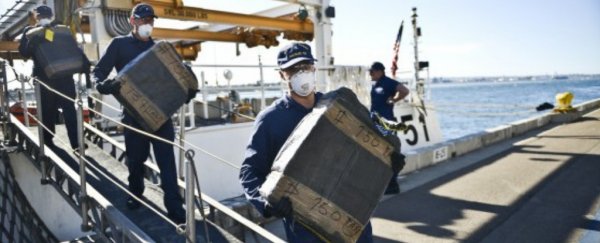After five decades of intense and expensive policing, the United States' so-called 'war on drugs' has only created a bigger problem, a new study has found.
The research is based on a unique geographic model, called NarcoLogic, that was designed to figure out how cocaine smuggling networks have adapted to US drug interception over the years.
It's a perennial cat-and-mouse game that's been going on since 1971. Yet despite the government spending up to almost US$5 billion federal dollars annually on the seizure and disruption of cocaine shipments, the new model has now corroborated what critics have long suspected: the mouse is winning.
"This work demonstrates that supply-side counterdrug strategies alone are, at best, ineffective and, at worst, intensifying the trafficking problem," says lead author Nicholas Magliocca, a geographer at the University of Alabama.
"These networks have demonstrated their ability to adapt to interdiction efforts, identifying and exploiting new trafficking routes in response."
Drawing on their own field research, as well as multiple empirical studies, government theoretical perspectives, and media reports, the authors were able to track where, when, and how cocaine was trafficked between 2000 and 2014.
It's the first time that smuggling routes through Central America have been explicitly modelled, and while many of these paths aren't mapped or even known, there is enough circumstantial evidence and classified intelligence to make some educated guesses.
The updated model now suggests that drug traffickers are actively adapting and adjusting their routes, exploiting new locations to get around US drug control. This essentially means that the very presence of law enforcement has only made drug trafficking more widespread and harder to eradicate.
As a result, between 1996 and 2017, the space that drug traffickers use has spread from roughly 5 million square kilometres (2 million square miles) to over 18 million square kilometres (7 million square miles) - a 3.5-fold increase that will only make future enforcement more difficult and expensive.
"In other words, narco-trafficking is as widespread and difficult to eradicate as it is because of interdiction, and increased interdiction will continue to spread traffickers into new areas, allowing them to continue to move drugs north," the authors write.
Today, counterdrug interdiction efforts are at the very core of US national security, receiving US$4.7 billion in 2016, or about 18 percent of federal drug control spending.
Primarily designed to seize or disrupt cocaine shipments in Guatemala, Honduras, El Salvador, Nicaragua, Costa Rica, and Panama, these efforts have had little effect on the supply of cocaine in the US, let alone its price.
"Wholesale cocaine prices in the United States have actually dropped significantly since 1980, deaths from cocaine overdose are rising, and counterdrug forces intercept cocaine shipments at a low rate," says co-author David Wrathall, a geographer at Oregon State University.
"More cocaine entered the United States in 2015 than in any other year."
Clearly, something is not working here, but the ramifications are not just limited to drug abuse. Wrathall says that as trafficking has spread, it's triggered a host of smuggling-related damages, including "violence, corruption, proliferation of weapons, and extensive and rapid environmental destruction".
This, in turn, has forced many people in Central America to flee drug-related violence in their own home countries - a particularly important point given the current furore over migrants in the US.
By creating a "virtual laboratory", the authors hope that their new model can help the US government predict such unintentional consequences, supplying federal authorities with the evidence they need to develop new and better drug policies.
"The study is a victory for observation and theory," says Wrathall.
"It tells us that increased interdiction will continue to push traffickers into new areas, spreading networks, and allowing them to continue to move drugs north."
This study has been published in PNAS.
